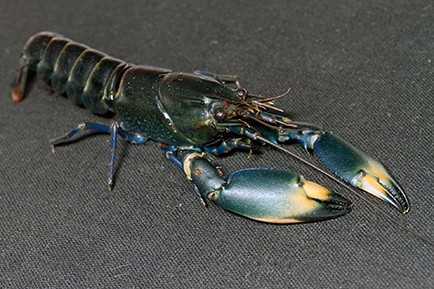Abstract
Cherax woworae n. sp. is a moderately-sized burrowing freshwater crayfish endemic to the Teminabuan District, South Sorong Regency, Southwest Papua Province, Indonesia. This species is one of many freshwater crayfish species from the region that are popular ornamental animals. In the pet trade, it is commonly known as the “Blue Moon Crayfish” or “Blue Kong Crayfish”. Cherax woworae is genetically and morphologically similar to Cherax gherardii Patoka, Bláha & Kouba, 2015, but both species may be easily distinguished morphologically and by their substantial genetic divergence.
References
- Bláha, M., Weiperth, A., Patoka, J., Szajbert, B., Balogh, E.R., Staszny, Á., Ferincz, Á., Lente, V., Maciaszek, R. & Kouba, A. (2022) The pet trade as a source of non-native decapods: the case of crayfish and shrimps in a thermal waterbody in Hungary. Environmental Monitoring and Assessment, 194, 795. https://doi.org/10.1007/s10661-022-10361-9
- Bláha, M., Patoka, J., Kozák, P. & Kouba, A. (2016) Unrecognized diversity in New Guinean crayfish species (Decapoda, Parastacidae): The evidence from molecular data. Integrative Zoology, 11, 457–468. https://doi.org/10.1111/1749-4877.12211
- Chucholl, C. (2013) Invaders for sale: trade and determinants of introduction of ornamental freshwater crayfish. Biological Invasions, 15, 125–141. https://doi.org/10.1007/s10530-012-0273-2
- Crandall, K.A. & De Grave, S. (2017) An updated classification of the freshwater crayfishes (Decapoda: Astacidea) of the world, with a complete species list. Journal of Crustacean Biology, 37, 615–653. https://doi.org/10.1093/jcbiol/rux070
- Crandall, K.A. & Fitzpatrick, J.J. (1996) Crayfish molecular systematics: Using a combination of procedures to estimate phylogeny. Systematic Biology, 45, 1–26. https://doi.org/10.1093/sysbio/45.1.1
- Darriba, D., Taboada, G.L., Doallo, R. & Posada, D. (2012) jModelTest 2: more models, new heuristics and parallel computing. Nature Methods, 9, 772–772. https://doi.org/10.1038/nmeth.2109
- Drummond, A.J. & Rambaut, A. (2007) BEAST: Bayesian evolutionary analysis by sampling trees. BMC Evolutionary Biology, 7, 214. https://doi.org/10.1186/1471-2148-7-214
- Faulkes, Z. (2015) The global trade in crayfish as pets. Crustacean Research, 44, 75–92. https://doi.org/10.18353/crustacea.44.0_75
- Folmer, O., Black, M., Hoeh, W., Lutz, R. & Vrijenhoek, R. (1994) DNA primers for amplification of mitochondrial Cytochrome C oxidase subunit I from diverse metazoan invertebrates. Molecular Marine Biology and Biotechnology, 3, 294–299.
- Katoh, K., Misawa, K., Kuma, K.-I. & Miyata, T. (2002) MAFFT: a novel method for rapid multiple sequence alignment based on fast Fourier transform. Nucleic Acids Research, 30, 3059–3066. https://doi.org/10.1093/nar/gkf436
- Kearse, M., Moir, R., Wilson, A., Stones-Havas, S., Cheung, M., Sturrock, S., Buxton, S., Cooper, A., Markowitz, S. & Duran, C. (2012) Geneious Basic: an integrated and extendable desktop software platform for the organization and analysis of sequence data. Bioinformatics, 28, 1647–1649. https://doi.org/10.1093/bioinformatics/bts199
- Lefébure, T., Douady, C., Gouy, M. & Gibert, J. (2006) Relationship between morphological taxonomy and molecular divergence within Crustacea: proposal of a molecular threshold to help species delimitation. Molecular Phylogenetics and Evolution, 40, 435–447. https://doi.org/10.1016/j.ympev.2006.03.014
- Lukhaup, C. & Eprilurahman, R. (2022) A new species of crayfish of the genus Cherax from Indonesian New Guinea (Crustacea, Decapoda, Parastacidae). Zoosystematics and Evolution, 98, 411–425. https://doi.org/10.3897/zse.98.94753
- Lukhaup, C., Eprilurahman, R. & Von Rintelen, T. (2018) Two new species of crayfish of the genus Cherax from Indonesian New Guinea (Crustacea, Decapoda, Parastacidae). ZooKeys, 769, 89–116. https://doi.org/10.3897/zookeys.769.26095
- Lukhaup, C. & Pekny, R. (2008) Cherax (Astaconephrops) boesemani, a new species of crayfish (Crustacea: Decapoda: Parastacidae) from the centre of the Vogelkop Peninsula in Irian Jaya (West New Guinea), Indonesia. Zoologische Mededelingen, Leiden, 82, 331–340.
- Patoka, J. (2020) Crayfish of New Guinea: Current status, exploitation and threats. In: Ribeiro, F. (Ed.), Crayfish: Evolution, Habitat and Conservation Strategies, Nova, New York, pp. 43–69.
- Patoka, J., Bláha, M. & Kouba, A. (2015a) Cherax (Astaconephrops) gherardii, a new crayfish (Decapoda: Parastacidae) from West Papua, Indonesia. Zootaxa, 3964 (5), 526–536. https://doi.org/10.11646/zootaxa.3964.5.2
- Patoka, J., Bláha, M. & Kouba, A. (2017) Cherax acherontis (Decapoda: Parastacidae), the first cave crayfish from the Southern Hemisphere (Papua Province, Indonesia). Zootaxa, 4363 (1), 137–144. https://doi.org/10.11646/zootaxa.4363.1.7
- Patoka, J., Kalous, L. & Kopecký, O. (2014) Risk assessment of the crayfish pet trade based on data from the Czech Republic. Biological Invasions, 16, 2489–2494. https://doi.org/10.1007/s10530-014-0682-5
- Patoka, J., Kalous, L. & Kopecký, O. (2015b) Imports of ornamental crayfish: the first decade from the Czech Republic’s perspective. Knowledge and Management of Aquatic Ecosystems, 416, 4. https://doi.org/10.1051/kmae/2014040
- Tamura, K., Stecher, G., Peterson, D., Filipski, A. & Kumar, S. (2013) MEGA6: molecular evolutionary genetics analysis version 6.0. Molecular Biology and Evolution, 30, 2725–2729. https://doi.org/10.1093/molbev/mst197
- Trifinopoulos, J., Nguyen, L.T., von Haeseler, A. & Minh, B.Q. (2016) W-IQ-TREE: a fast online phylogenetic tool for maximum likelihood analysis. Nucleic Acids Research, 44, 232–235. https://doi.org/10.1093/nar/gkw256
- Weiperth, A., Bláha, M., Szajbert, B., Seprős, R., Bányai, Z., Patoka, J. & Kouba, A. (2020) Hungary: a European hotspot of non-native crayfish biodiversity. Knowledge and Management of Aquatic Ecosystems, 421, 43. https://doi.org/10.1051/kmae/2020035
- Yonvitner, Y., Patoka, J., Yuliana, E., Bohatá, L., Tricarico, E., Karella, T., Kouba, A. & Reynolds, J.D. (2020) Enigmatic hotspot of crayfish diversity at risk: Invasive potential of non-indigenous crayfish if introduced to New Guinea. Aquatic Conservation: Marine and Freshwater Ecosystems, 30, 219–224. https://doi.org/10.1002/aqc.3276
- Yuliana, E., Yonvitner, A.S., Subing, R., Ritonga, S., Santoso, A., Kouba, A. & Patoka, J. (2021) Import, trade and culture of non-native ornamental crayfish in Java, Indonesia. Management of Biological Invasions, 12, 846–857. https://doi.org/10.3391/mbi.2021.12.4.05


